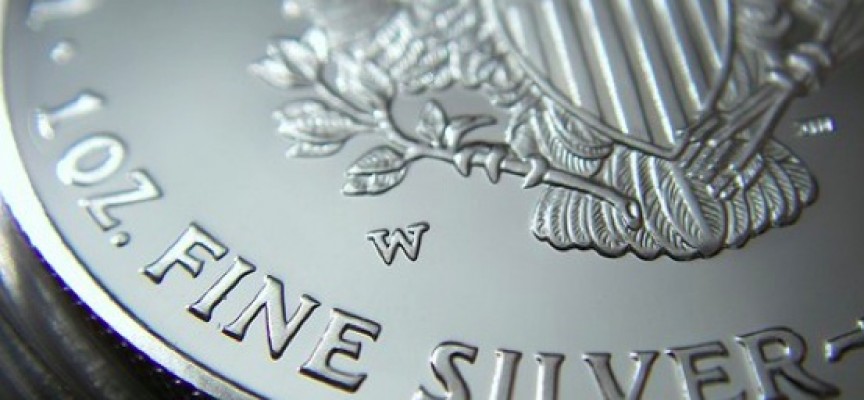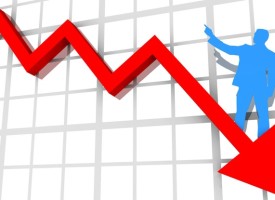On the heels of the Fed leaving interest rates unchanged, they continued with their propaganda campaign to convince people that inflation is transitory and that they are going to end stimulus. Of course this is nonsense but it is the world we live in today. Meanwhile, Sprott says gold is poised to climb post-Fed decision but silver may really surprise.
Gold Poised To Climb
November 3 (King World News) – Paul Wong, Market Strategist at Sprott Asset Management: Gold bullion regained some ground in October, climbing 1.50% for the month. Gold, however, remains underwater at -6.06% YTD through October 31, 2021. Gold mining equities also rebounded in October, up 8.15%, but are down 11.35% YTD as of October 31. Silver gained ground in October (7.81%) but is down 9.47% YTD.
October in Review
Spot gold closed October at $1,783.38, gaining $26.43 for the month (or 1.50%). Gold managed to recover from the late September swoon that saw a positioning cleanse, which sent the entire precious metals complex into extreme oversold conditions. Most of the late September pressure originated from heavy selling in call options across the board (GLD ETF call options for gold, December futures calls for silver and GDX call options). The Federal Reserve (“Fed”) taper signal at its September 22 Federal Open Marketing Committee Meeting (FOMC) coincided with the September quarterly options expiry, amplifying gold price swings. The liquidation of gold positions continued but slowed in October, and gold’s positive divergent price action is a sign of selling exhaustion. We will expand on this point in the positioning data later in the commentary.
Gold continues to feel pressure from the market’s intense focus on pricing in the developed central banks’ exits from the COVID-pandemic stimulus, despite the evident inflationary pressures and policy mistake risk. Global bond markets have aggressively raised their expectations for policy tightening, as surging energy prices and rampant supply chain issues have propelled inflation higher. The U.S. bond market has now moved up the date of pricing in the first hike for July 2022 despite tapering expected to end by June 2022. Still, this extreme hawkish view of Fed hikes may not force the desired Fed response.
The Fed continues to view this current inflation wave in transitory terms and is aware that cost-push inflation generally does not respond to rate hikes. The market is pricing in a policy mistake (tightening into a slowdown). The Fed’s reaction function will stay primed to a growth outcome more than to inflation. In other words, the Fed is likely to err on the side of growth with inflation than to risk a recession for a low inflation outcome. If the Fed does not meet the market’s expected hawkish response (more than mere tapering), it will likely pivot and seek out inflation protection assets (such as gold) if the Fed is willing to “run it hot.” No matter how the bond market reacts in the short term, the Fed will begin the taper process and combined with the current fiscal deceleration, these two forces will lower the growth outlook.
Technical Chart Updates
Since the August 2020 peak, gold has been carving out a corrective pattern (red concave line below the downtrend line). Despite the many negative headlines, selling waves and temporarily broken support levels, there has been no sustained selling; instead, we have seen multiple mean-reverting trade events.
The Challenges Begin to Mount: Eyes on China and Energy
As we advance into the fourth quarter of 2021, there are no shortages of challenges facing markets. The ongoing global COVID pandemic continues while monetary and fiscal impulses have already turned lower and will continue to trend lower through at least mid-2022 — or until a risk event forces policymakers to reverse course back to stimulus. Personal and corporate taxes are set to rise, and inflation is at its highest level in decades and still climbing. Raw material shortages, labor shortages and supply chain disruptions are expected to last well into 2022. Topping these headwinds, however, are the numerous challenges facing China and the burgeoning global energy crisis; we see these challenges as having the most significant potential for tail-type risks.
Let’s address China. The risk of a severe, extended property-led slowdown in China is rising. China’s position as the second-largest and fastest-growing major economy over the past two decades means that the global economy is inextricably linked to China. A smooth decoupling is unlikely. China’s current regulatory tightening cycle is beyond anything seen in the past in its breadth, severity and duration. The crackdown in the property market continues to slow growth and raise the potential for systemic risks. The China property market is one of the largest asset classes globally, accounting for approximately 20% of China’s gross domestic product (GDP) and about two-thirds of its household assets. China appears committed to deleveraging its property market, sacrificing short-term growth, while hoping to avoid tripping any systematic risk event that would endanger a hard landing. Other significant growth headwinds for China include a further power crunch (more global supply chain disruptions), a zero-tolerance COVID policy (more lockdowns) and numerous social goals (curbing inequality and environmental targets). Our view is that a shock event followed by a flood of stimulus is on the table.
An Energy Crisis Feels Close at Hand
Surging global prices across the entire energy chain (natural gas, coal, liquefied natural gas (LNG), electricity, oil, etc.) are among the primary sources of a stagflation threat. Surging energy prices add to high inflationary pressures, while power outages and high prices or demand destruction drag on growth. Years of under-investment in energy combined with ESG (environmental, social and governance) investment restrictions, geopolitics and other ideological limits have created the conditions for an energy crisis. Surging demand for energy products (especially LNG), along with operational supply issues, are creating eye-popping global price spikes.
We have seen natural gas trade at the rough equivalent of a $200 barrel of oil in the European Union (EU), while China is experiencing rolling blackouts and rationing. We are seemingly a cold winter away from the next energy shock event. The energy crisis is not going away soon since there is no quick supply fix after several years of underinvestment. And it won’t come from demand destruction as no policymaker anywhere wants to take that path. As we transition away to greener energy sources, power crunches will be ongoing. Whether it is a geopolitical event or cold winter, our view is that the risk of a full-blown energy crisis capable of destabilizing financial markets and economies is close at hand…
ALERT:
Billionaire and mining legend Ross Beaty, Chairman of Pan American Silver, just spoke about what he expects to see in the gold and silver markets and also shared one of his top stock picks in the mining sector CLICK HERE OR ON THE IMAGE BELOW TO HEAR BEATY’S INTERVIEW.

Fed Dilemma: Inflation, Stagflation or Bad Inflation
Inflation continues to broaden out (especially via energy price increases), inconsistent with the Fed’s “transitory” outlook. When the Fed set out over a year ago with AIT (average inflation targeting), it likely focused on inflation’s “good reflation” aspect (i.e., full and inclusive employment and avoiding a descent into a Japan-style never-ending deflation). Also, the Fed probably saw any inflation overshoot(s) as mostly benign and likely to retreat as the COVID pandemic waned. Instead, we are witnessing big inflation overshoots in the areas most painful (energy, food and consumer goods) to the disadvantaged consumer groups that the Fed tried to help with AIT.
The stagflation scenario (below-trend growth with above-trend inflation) also continues to be a market concern. Historically, stagflationary periods have been the most challenging investment environments and have demonstrated the worst historical performance for equities (sales weak, costs up, margins down, high rates compress valuation multiples, etc.).
In today’s modern market structure, stagflation brings new additional capital market risks. Namely, nobody (humans or machines) knows how to trade in a stagflationary market. Humans have seen nothing but a 40-year long secular bond bull market. Virtually a vast majority of quant-type funds and their VaR (value at risk) rules were built and calibrated in the post-GFC (global financial crisis) slow-flation, low-volatility market regime, the antithesis of a stagflationary world.
Central Banks “Pushing on a String”
In the years after the GFC, central banks have pushed on a string trying to reflate the real economy. Now the question pivots to, can central banks reign in real-world inflation caused by an extraneous shock without unduly damaging growth? If policymakers and politicians see inflation damaging growth and approval ratings, will policy pivot from pro-growth to anti-inflation? In a cost-push inflation environment, rate hikes cannot fix broken supply chains or increase supply across the energy chain; however, they can destroy demand.
Fed in a Quandary, Markets at an Inflection Point
That leaves the Fed in a quandary. Does the Fed a) remain ultra-accommodative and risk that prices spiral higher, or b) tighten to preempt inflationary pressures and exacerbate the slowdown? Neither scenario under the current market conditions is attractive. Under the first scenario (stay accommodative), the market will likely move to inflation protection assets, and bond yields will continue to rise, pressuring valuations. If growth recovers and outpaces yield increases, then conditions will stabilize. Thus far, the U.S. Treasury 2YR/10YR and 5YR/30YR bond yield curves are responding with an emphatic “no,” as both curves continue to fall on growth concerns driven by fears of Fed policy mistakes.
The second scenario — (b) in which the market is pricing (aggressive tightening) —could exacerbate the current slowdown and affect market valuations and increase market volatility and risk. It would also be alarmingly close to regime change territory. The challenge with leaving a highly accommodative monetary policy in place is that money and assets are priced off the risk-free rate. With the risk-free rate at zero (or below) for such a long time, asset prices have long adapted and adjusted…
With surface samples as high as a staggering 300,000
grams of silver, this company is looking to make
one of the largest silver discoveries in history!
CLICK HERE OR IMAGE BELOW TO FIND OUT MORE.

Even a slight increase in the Fed Funds rate or a small reduction in the Fed’s balance sheet (see 2018 Fed action) could dramatically impact asset prices and may quickly lead to tighter financial conditions. There are enormous amounts of duration embedded in all markets and asset classes, a legacy of central bank extreme ultra-accommodative policy since the GFC. The risk of a Fed policy mistake is there (tightening into a slowdown), but so are deeper more embedded market risks. In this scenario, we epcet safe-haven assets like gold and other precious metals to quickly be re-priced and back into demand.
Precious Metals Positioning Update: Well Positioned for 2013…
As we head toward year-end, market expectations have come down dramatically on the global economic growth outlook. Inflation has been more than persistent with the bond market pricing in aggressive rate hikes and fears of a Fed policy mistake.
Throughout 2021, positioning in precious metals has been reduced significantly, to the point where it has likely fully discounted the Fed’s coming taper/tightening action, essentially pricing in a 2013 replay of the gold sell-off. However, in 2013/14, there was no economic growth concern (yield curve was steepening) and there was low inflation risk.
The weaker precious metals prices since June of this year reflect a hyper-focus on the coming Fed taper/tightening but ignore the consequences of a Fed policy mistake and the building inflation risk. There are other growing right-tail risk events that are supportive for gold. For example, a cold winter could send energy prices soaring and stagflationary risk higher in an asymmetrical manner. And or a financial risk event in China could send global growth tumbling while bringing forward the prospect of another eventual round of global central bank stimulus, pulling forward inflation sentiment higher.
When the Fed’s taper announcement finally arrives, it may turn out to be a “buy on the news” event for gold. While the bond market is experiencing a violent re-pricing in the short end due to uncertainty around taper/tightening, precious metals have already priced in taper/tightening. Figure 4 shows positioning data extracted from our custom Sprott Sentiment Indices. The data represents multiple sources of holdings for gold, silver and gold equities, which are then normalized over a rolling two-year period. Gold bullion holdings, in particular, have been wiped out. We are likely heading towards an inflection point in the market with precious metals positioning at washed-out levels. Our positioning data would indicate the potential upward price squeeze has become significant.
Looking Under the Hood of Gold Positioning Sentiment
The positioning graphs in Figure 4 are an amalgamation of different sources of gold holdings, but sometimes the details become obscured for simplicity. Figure 5 is total open interest in GLD ETF calls minus puts, expressed in notional ounces for easier comparison. As a reminder, these are notional ounces; the market value will be determined by how far out of the money the strike prices are. We overlayed gold held in ETFs, the largest aggregation of gold ounces, to illustrate how potentially significant GLD calls can be. This measure has made new 10-year lows, lower than any point during the bear market in terms of speculative interest via options.
Silver Positioning: The Devil’s in the Details
Figure 6 shows the amount of silver in ounces, held in ETFs and held in CFTC (Commodity Futures Trading Commission) Net Non-Commercial and Managed Futures. Silver in ETFs (primarily retail and smaller funds) is remarkably steady, as seen in the blue line in Figure 6. Note the doubling of silver ounces in ETFs in 2020. Visually, it is clear that CFTC and managed futures account for virtually all trading volatility. Since 2016, note the increase in the amplitude of positioning swings as quantitative-types (mainly CTAs, or commodity trading advisor hedge funds) become dominant. The wild swings in CFTC positioning are most certainly not dictated by conventional fundamental drivers but by algorithmic metrics.
Though the number of silver ounces held in ETFs (1.06 billion ounces) is now about four times the long-term average of CFTC positioning (283 million ounces), the trading volatility remains unchanged. With more ounces held in ETFs (passives) reducing overall net liquidity, the more the tail is wagging the dog. It is not difficult to envision what would happen if everyone decided to buy silver at once.
A Changing Landscape
The extraordinary monetary stimulus unleashed by the global central banks in response to the COVID pandemic is ending. The fiscal impulse has also peaked and will be trending lower. The worldwide surge in inflation has already pressured several developed central banks to taper/tighten very abruptly. The Fed appears set to begin its taper process this week at its November 2-3 FOMC meeting. Already, the U.S. bond market is pricing in a policy mistake (tightening into a slowdown). As I have noted, the Fed is in a quandary; it will either have to tighten conditions to head off inflation and risk slowing growth even further, or the Fed will remain accommodative to continue growth and risk broadening and pushing inflation. Either option will elevate market risk conditions.
Gold is likely to react positively to either scenario, with the higher inflation one being more immediate. Either way, precious metals positioning has been brought down to low enough levels that any upward pressure would see prices advance meaningfully. We believe that precious metals are set up for a squeeze higher and are simply awaiting a catalyst. Remember, catalysts speed up reactions, and there appear to be several sources of potential activation energy for gold.
***ALSO JUST RELEASED: What Is Happening Right Now Is Truly Stunning CLICK HERE.
***ALSO JUST RELEASED: Greyerz – Vast Fortunes Will Be Wiped Out In Coming Years, Plus Two Fascinating Emails From Readers CLICK HERE.
***To listen to the top trends forecaster in the world discuss the inflation spiral, gold, silver, Bitcoin, and more CLICK HERE OR ON THE IMAGE BELOW.
***To listen to Alasdair Macleod discuss gold, silver, Bitcoin, and more CLICK HERE OR ON THE IMAGE BELOW.
© 2021 by King World News®. All Rights Reserved. This material may not be published, broadcast, rewritten, or redistributed. However, linking directly to the articles is permitted and encouraged.















